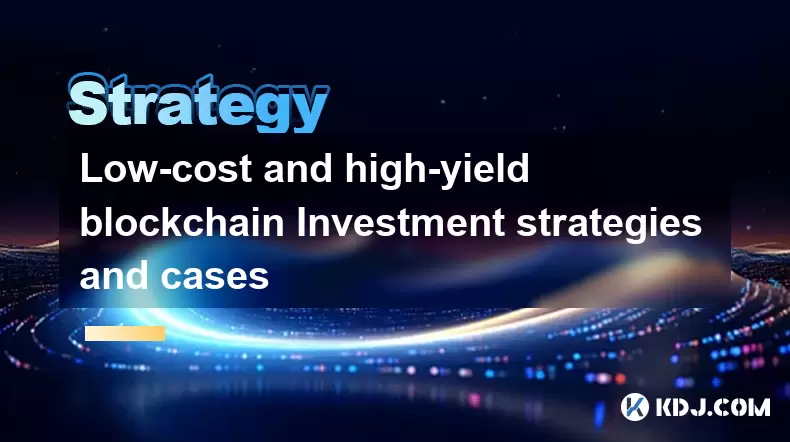-
 bitcoin
bitcoin $122025.899241 USD
-2.12% -
 ethereum
ethereum $4488.068729 USD
-4.11% -
 bnb
bnb $1315.348019 USD
8.65% -
 tether
tether $1.000457 USD
0.03% -
 xrp
xrp $2.875326 USD
-3.69% -
 solana
solana $222.043604 USD
-4.07% -
 usd-coin
usd-coin $0.999682 USD
0.00% -
 dogecoin
dogecoin $0.249887 USD
-5.62% -
 tron
tron $0.337379 USD
-2.59% -
 cardano
cardano $0.827763 USD
-5.06% -
 hyperliquid
hyperliquid $45.774531 USD
-2.43% -
 chainlink
chainlink $22.079309 USD
-5.87% -
 ethena-usde
ethena-usde $1.000156 USD
0.02% -
 sui
sui $3.482566 USD
-3.57% -
 stellar
stellar $0.386982 USD
-4.92%
Low-cost and high-yield blockchain Investment strategies and cases
Investors can achieve significant returns in blockchain by exploring low-cost strategies like early altcoin investments and high-yield approaches such as staking and yield farming.
May 28, 2025 at 11:02 am

In the dynamic world of cryptocurrencies, finding low-cost and high-yield blockchain investment strategies is a pursuit that many investors undertake. This article will explore various strategies and real-world cases that exemplify how investors can achieve significant returns without substantial initial investments. Understanding these approaches can help you make informed decisions and potentially maximize your returns in the blockchain space.
Understanding Low-Cost Blockchain Investments
Low-cost blockchain investments typically refer to entry points that require minimal capital but have the potential for high returns. These can include investing in lesser-known cryptocurrencies, participating in initial coin offerings (ICOs), or engaging in decentralized finance (DeFi) protocols. The key is to identify opportunities where the risk-reward ratio is favorable and the entry barrier is low.
For instance, investing in altcoins that are in their early stages can be a low-cost strategy. These cryptocurrencies often have lower market caps and can offer significant growth potential if they gain traction. However, they also come with higher volatility and risk, so thorough research is essential.
High-Yield Investment Strategies in Blockchain
High-yield investment strategies in the blockchain space can vary widely, but they often involve leveraging the unique features of blockchain technology, such as smart contracts and decentralized platforms. Some popular high-yield strategies include staking, yield farming, and liquidity provision.
Staking involves holding certain cryptocurrencies in a wallet to support the operations of a blockchain network. In return, stakers receive rewards, often in the form of additional tokens. This can be a relatively passive way to earn high yields, especially with proof-of-stake (PoS) cryptocurrencies like Ethereum 2.0.
Yield farming and liquidity provision in DeFi platforms are other high-yield strategies. These involve providing liquidity to decentralized exchanges or lending platforms and earning rewards based on the demand for the tokens you provide. These strategies can be more complex and require a deeper understanding of the DeFi ecosystem but can offer significant returns.
Case Study: Investing in Early-Stage Altcoins
A notable case of a low-cost and high-yield investment in the blockchain space is the early investment in Cardano (ADA). In its early days, Cardano was a relatively unknown project with a low market cap. Investors who bought ADA at its initial stages, around $0.02 in 2017, saw their investments grow significantly as the project gained popularity and the price soared to over $3 in 2021.
The key to success in this case was identifying a project with strong fundamentals and a promising roadmap. Cardano's focus on academic research and its methodical approach to development attracted investors who believed in its long-term potential. This example underscores the importance of due diligence and the potential rewards of investing in undervalued projects.
Case Study: Yield Farming on DeFi Platforms
Another successful case of a high-yield blockchain investment strategy is yield farming on platforms like Compound and Uniswap. Yield farming involves providing liquidity to decentralized protocols and earning rewards in the form of tokens. For example, an investor who provided liquidity to Uniswap's ETH/DAI pool in early 2020 could have earned significant yields in the form of UNI tokens, which were distributed to liquidity providers.
To participate in yield farming on Uniswap, an investor would follow these steps:
- Connect a wallet: Use a compatible wallet like MetaMask to connect to the Uniswap platform.
- Select a pool: Choose the ETH/DAI liquidity pool, for example.
- Provide liquidity: Deposit an equal value of ETH and DAI into the pool.
- Earn rewards: Receive UNI tokens as rewards for providing liquidity.
This strategy requires a good understanding of the risks involved, such as impermanent loss and smart contract risks, but can offer high yields for those willing to navigate the complexities of DeFi.
Case Study: Staking in Proof-of-Stake Networks
Staking in proof-of-stake networks is another example of a low-cost and high-yield investment strategy. A case in point is staking in the Tezos (XTZ) network. Tezos uses a proof-of-stake consensus mechanism, allowing token holders to participate in network validation and earn rewards.
To stake Tezos, an investor would:
- Acquire XTZ tokens: Purchase Tezos tokens from a cryptocurrency exchange.
- Set up a Tezos wallet: Use a wallet that supports Tezos staking, such as the Tezos Foundation's official wallet or a hardware wallet like Ledger.
- Delegate to a baker: Choose a Tezos baker (validator) to delegate your tokens to. This can be done directly through the wallet interface.
- Earn rewards: Receive staking rewards based on the amount of XTZ delegated and the performance of the chosen baker.
Staking in Tezos can offer annual yields of around 5-7%, which is significantly higher than traditional savings accounts. This strategy is relatively passive and can be a low-cost way to earn high yields in the blockchain space.
Case Study: Participating in ICOs
Initial Coin Offerings (ICOs) have been another avenue for low-cost and high-yield blockchain investments. A notable example is the Ethereum (ETH) ICO in 2014. Investors who participated in the Ethereum ICO at $0.31 per ETH saw their investments grow exponentially as the price of ETH reached over $4,000 in 2021.
Participating in an ICO involves:
- Researching the project: Thoroughly review the project's whitepaper, team, and roadmap to assess its potential.
- Registering on the ICO platform: Sign up on the platform hosting the ICO, such as Ethereum's initial sale on its website.
- Purchasing tokens: Use cryptocurrencies like Bitcoin or Ethereum to buy the new tokens during the ICO period.
- Holding or trading: Decide whether to hold the tokens for long-term growth or trade them on exchanges once they are listed.
While ICOs can offer high returns, they also come with significant risks, including the potential for scams and regulatory issues. Therefore, due diligence is crucial when considering this investment strategy.
Frequently Asked Questions
Q: How can I identify low-cost blockchain investment opportunities?A: Identifying low-cost blockchain investment opportunities involves researching lesser-known projects with strong fundamentals. Look for projects with a clear roadmap, a solid team, and a unique value proposition. Platforms like CoinMarketCap and CoinGecko can help you find altcoins with low market caps that may offer high growth potential.
Q: What are the risks associated with high-yield blockchain investment strategies?A: High-yield blockchain investment strategies come with several risks, including smart contract vulnerabilities, market volatility, and the potential for rug pulls in DeFi. It's essential to understand these risks and only invest what you can afford to lose. Diversifying your investments can also help mitigate some of these risks.
Q: Can I participate in yield farming without extensive technical knowledge?A: While yield farming can be complex, there are user-friendly platforms and guides available that can help beginners get started. Platforms like Yearn.finance and Aave offer simpler interfaces for yield farming. However, it's crucial to spend time learning about the basics of DeFi and the specific risks involved before diving in.
Q: How important is it to stay updated with blockchain technology trends?A: Staying updated with blockchain technology trends is crucial for making informed investment decisions. The blockchain space evolves rapidly, and new opportunities and risks emerge frequently. Following reputable sources, joining blockchain communities, and participating in forums can help you stay informed and identify potential investment opportunities.
Disclaimer:info@kdj.com
The information provided is not trading advice. kdj.com does not assume any responsibility for any investments made based on the information provided in this article. Cryptocurrencies are highly volatile and it is highly recommended that you invest with caution after thorough research!
If you believe that the content used on this website infringes your copyright, please contact us immediately (info@kdj.com) and we will delete it promptly.
- BlockDAG, DOGE, HYPE Sponsorship: Crypto Trends Shaping 2025
- 2025-10-01 00:25:13
- Deutsche Börse and Circle: A StableCoin Adoption Powerhouse in Europe
- 2025-10-01 00:25:13
- BlockDAG's Presale Buzz: Is It the Crypto to Watch in October 2025?
- 2025-10-01 00:30:13
- Bitcoin, Crypto, and IQ: When Genius Meets Digital Gold?
- 2025-10-01 00:30:13
- Stablecoins, American Innovation, and Wallet Tokens: The Next Frontier
- 2025-10-01 00:35:12
- NBU, Coins, and Crypto in Ukraine: A New Yorker's Take
- 2025-10-01 00:45:14
Related knowledge

Practical parameter settings for a Bitcoin multi-timeframe moving average system
Sep 18,2025 at 10:54pm
Optimizing Timeframe Combinations for Bitcoin Trading1. Selecting appropriate timeframes is crucial when building a multi-timeframe moving average sys...

How can I filter out false breakouts in Dogecoin high-frequency trading?
Sep 22,2025 at 01:00am
Understanding False Breakouts in Dogecoin Trading1. A false breakout occurs when Dogecoin's price appears to move beyond a defined support or resistan...

Techniques for identifying tops and bottoms in the Bitcoin on-chain NVT model
Sep 20,2025 at 07:54pm
Understanding the NVT Model in Bitcoin Analysis1. The Network Value to Transactions (NVT) ratio is often described as the 'P/E ratio' of the cryptocur...

What does the surge in open interest in Bitcoincoin futures mean?
Sep 20,2025 at 11:18pm
Understanding the Surge in Dogecoin Futures Open Interest1. A surge in open interest within Dogecoin futures indicates a growing number of active cont...

How can I use the Ethereum USDT premium to gauge market sentiment?
Sep 18,2025 at 11:55pm
Understanding the Ethereum USDT Premium1. The Ethereum USDT premium refers to the price difference between USDT (Tether) traded on Ethereum-based plat...

What should I do if Ethereum staking yields decline?
Sep 20,2025 at 06:18am
Understanding the Causes Behind Declining Ethereum Staking Yields1. The Ethereum network transitioned to a proof-of-stake consensus mechanism with the...

Practical parameter settings for a Bitcoin multi-timeframe moving average system
Sep 18,2025 at 10:54pm
Optimizing Timeframe Combinations for Bitcoin Trading1. Selecting appropriate timeframes is crucial when building a multi-timeframe moving average sys...

How can I filter out false breakouts in Dogecoin high-frequency trading?
Sep 22,2025 at 01:00am
Understanding False Breakouts in Dogecoin Trading1. A false breakout occurs when Dogecoin's price appears to move beyond a defined support or resistan...

Techniques for identifying tops and bottoms in the Bitcoin on-chain NVT model
Sep 20,2025 at 07:54pm
Understanding the NVT Model in Bitcoin Analysis1. The Network Value to Transactions (NVT) ratio is often described as the 'P/E ratio' of the cryptocur...

What does the surge in open interest in Bitcoincoin futures mean?
Sep 20,2025 at 11:18pm
Understanding the Surge in Dogecoin Futures Open Interest1. A surge in open interest within Dogecoin futures indicates a growing number of active cont...

How can I use the Ethereum USDT premium to gauge market sentiment?
Sep 18,2025 at 11:55pm
Understanding the Ethereum USDT Premium1. The Ethereum USDT premium refers to the price difference between USDT (Tether) traded on Ethereum-based plat...

What should I do if Ethereum staking yields decline?
Sep 20,2025 at 06:18am
Understanding the Causes Behind Declining Ethereum Staking Yields1. The Ethereum network transitioned to a proof-of-stake consensus mechanism with the...
See all articles










































































